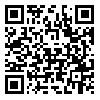دوره 21، شماره 4 - ( 9-1403 )
جلد 21 شماره 4 صفحات 46-41 |
برگشت به فهرست نسخه ها
Download citation:
BibTeX | RIS | EndNote | Medlars | ProCite | Reference Manager | RefWorks
Send citation to:



BibTeX | RIS | EndNote | Medlars | ProCite | Reference Manager | RefWorks
Send citation to:
Beirami A, Rahemi Z. Investigating the effect of mindfulness-based art therapy on self-efficacy of multiparous and nulliparous women: A randomized controlled trial. J Res Dev Nurs Midw 2024; 21 (4) :41-46
URL: http://nmj.goums.ac.ir/article-1-1872-fa.html
URL: http://nmj.goums.ac.ir/article-1-1872-fa.html
Investigating the effect of mindfulness-based art therapy on self-efficacy of multiparous and nulliparous women: A randomized controlled trial. Journal of Research Development in Nursing and Midwifery. 1403; 21 (4) :41-46
چکیده: (2690 مشاهده)
Background: Labor pain is a common concern among pregnant women, leading to fear and anxiety. Enhancing self-efficacy can play a crucial role in managing these complications. This study aims to evaluate the effect of mindfulness-based art therapy on the self-efficacy of multiparous and nulliparous women.
Methods: The present study was a randomized clinical trial with three parallel intervention arms (multiparous and nulliparous groups) and a control. The statistical population of the study included pregnant women (multiparous and nulliparous groups) referring to health centers (public and private) in Bandar Abbas city for prenatal care. A total sample size of 90 participants was determined, with 30 individuals randomly assigned to each group using a block randomization method. Participants were selected based on inclusion and exclusion criteria. Interventions were conducted in eight sessions, with 3 to 15 people in each group, in a face-to-face and coherent manner. Participants in the intervention and control groups were assessed three times: before the intervention, immediately after the intervention, and four weeks after the intervention using the Iranian Childbirth Self-Efficacy Questionnaire and the Five-Factor Mindfulness Questionnaire. The data were then analyzed using SPSS version 26 software, employing ANOVA and repeated measures tests. A significance level of less than 0.05 was considered.
Results: The mean self-efficacy scores for expectations during the active stage of labor immediately after the intervention were 162.07±11.28 (nulliparous), 163.07±12.02 (multiparous), and 145.77±27.50 (control group). Four weeks post-intervention, the scores were 162.07±11.98 (nulliparous), 163.07±12.02 (multiparous), and 145.77±27.50 (control group). The mean self-efficacy scores for expectations during the fourth stage of labor immediately after the intervention were 155.21±10.80 (nulliparous), 156.21±11.12 (multiparous), and 122.77±24.96 (control group). Four weeks after the intervention, these scores were 152.46±10.29 (nulliparous), 154.23±11.34 (multiparous), and 121.23±27.42 (control group). The mean mindfulness scores in both intervention groups (multiparous and nulliparous) were significantly higher immediately after the intervention (p=0.001) and four weeks later (p=0.001) compared to baseline.
Conclusion: The results indicated the effectiveness of mindfulness-based art therapy in enhancing self-efficacy and mindfulness among pregnant women. Thus, it is recommended that this therapeutic method be utilized to manage and reduce the fear of childbirth in pregnant women.
Methods: The present study was a randomized clinical trial with three parallel intervention arms (multiparous and nulliparous groups) and a control. The statistical population of the study included pregnant women (multiparous and nulliparous groups) referring to health centers (public and private) in Bandar Abbas city for prenatal care. A total sample size of 90 participants was determined, with 30 individuals randomly assigned to each group using a block randomization method. Participants were selected based on inclusion and exclusion criteria. Interventions were conducted in eight sessions, with 3 to 15 people in each group, in a face-to-face and coherent manner. Participants in the intervention and control groups were assessed three times: before the intervention, immediately after the intervention, and four weeks after the intervention using the Iranian Childbirth Self-Efficacy Questionnaire and the Five-Factor Mindfulness Questionnaire. The data were then analyzed using SPSS version 26 software, employing ANOVA and repeated measures tests. A significance level of less than 0.05 was considered.
Results: The mean self-efficacy scores for expectations during the active stage of labor immediately after the intervention were 162.07±11.28 (nulliparous), 163.07±12.02 (multiparous), and 145.77±27.50 (control group). Four weeks post-intervention, the scores were 162.07±11.98 (nulliparous), 163.07±12.02 (multiparous), and 145.77±27.50 (control group). The mean self-efficacy scores for expectations during the fourth stage of labor immediately after the intervention were 155.21±10.80 (nulliparous), 156.21±11.12 (multiparous), and 122.77±24.96 (control group). Four weeks after the intervention, these scores were 152.46±10.29 (nulliparous), 154.23±11.34 (multiparous), and 121.23±27.42 (control group). The mean mindfulness scores in both intervention groups (multiparous and nulliparous) were significantly higher immediately after the intervention (p=0.001) and four weeks later (p=0.001) compared to baseline.
Conclusion: The results indicated the effectiveness of mindfulness-based art therapy in enhancing self-efficacy and mindfulness among pregnant women. Thus, it is recommended that this therapeutic method be utilized to manage and reduce the fear of childbirth in pregnant women.
| بازنشر اطلاعات | |
 |
این مقاله تحت شرایط Creative Commons Attribution-NonCommercial 4.0 International License قابل بازنشر است. |




